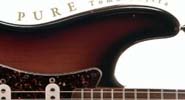 The Electro-Harmonix Ravish Sitar pedal uses guitar signal to produce a polyphonic lead voice and tunable sympathetic string drones that react to a player’s dynamic touch. It allows the player to create custom scales for the sympathetic strings while setting the decay time for the lead voice. Used with two expression pedals (it has inputs for each), it can bend the pitch of the lead voice and control the volume of the sympathetic strings simultaneously. Learn more at ehx.com.
The Electro-Harmonix Ravish Sitar pedal uses guitar signal to produce a polyphonic lead voice and tunable sympathetic string drones that react to a player’s dynamic touch. It allows the player to create custom scales for the sympathetic strings while setting the decay time for the lead voice. Used with two expression pedals (it has inputs for each), it can bend the pitch of the lead voice and control the volume of the sympathetic strings simultaneously. Learn more at ehx.com.
Month: August 2011
-
Electro-Harmonix Intros Ravish Sitar Pedal
-

Sasha Dobson
 Sasha Dobson is the daughter of a pair of jazz players and has worked as a jazz singer herself. She has also been a staple on the indie-folk music scene in and around New York City, and more recently has been on the road playing guitar and banjo for Norah Jones.
Sasha Dobson is the daughter of a pair of jazz players and has worked as a jazz singer herself. She has also been a staple on the indie-folk music scene in and around New York City, and more recently has been on the road playing guitar and banjo for Norah Jones.Dobson has been compared to acts like Sheryl Crow and Cat Power but that’s almost a disservice. Her songs are more deeply passionate and less poppy than Crow’s, and she’s more dynamic and rhythmically solid than Power. And she sings circles around both. Dobson plays acoustic and electric on the disc, and in guitarist Steve Elliott she has the perfect match; he displays a confident deliberateness stressing melody over f lash and constructs parts with rich tone, strong vibrato, and an unhurried but impassioned approach, whether on the slightly quirky semi-pop of “Family” or the rhythmic, smoldering, jazz-folk of the title song. Elliott adds lap steel to “Make It Alright” which, like the haunting “Let Me Go,” has echoes of the BoDeans, while the sultry “You’ll Forget Me” does a lot to justify the comparisons of Dobson with Lucinda Williams. Yet Dobson is not a country, jazz, folk or pop artist. She’s a unique, original writer and musician who just seems to write them as she feels them.
This article originally appeared in VG’s Oct. ’10 issue. All copyrights are by the author and Vintage Guitar magazine. Unauthorized replication or use is strictly prohibited.
-
Fender Intros New Acoustasonic Combos
Fender’s Acoustasonic 100 Combo and Acoustasonic 150 Combo amps are equipped with a new Voicing control that can be turned off for pure amp output response. The feature also supports acoustic players who double on electric guitar. It includes Blackface, tweed, and British amp settings, which makes a second amp just for electric guitar unnecessary.
The Acoustic 100 Combo, 100-watt power amp uses an 8” foam-surround low-frequency driver and high-frequency tweeter, allowing for crystal clarity and high fidelity. The Acoustasonic 150, 150-watt, stereo power amp is equipped with two 8” foam-surround, low-frequency drivers and high-frequency tweeter, allowing for increased volume and improved acoustic tonality.
Other features include instrument and microphone channels with independent EQ and effects controls; new feedback elimination control with on/off switch for each channel; patented String Dynamics control that tames harsh treble notes; effects including reverb, delay, chorus, Vibratone, and more; XLR line out with level control and ground lift; stereo effects loop and a USB connector for digital recording output. Check them out at fender.com.
-
BC Audio Launches Combo Amps
 BC Audio has introduced 1×12 combo versions of its tube guitar amps, including the No. 7 and “hot-rod plexi” No. 8. Amplifier No. 7 is a 15 or 25 watt non-master volume amp featuring Bright and Normal channels and Presence, utilizing 6V6 or 5881 output tubes, a 5Y3 or GZ34 tube rectifier and 6SL7 octal preamp tubes. Amplifier No. 8 is a 25-watt high-gain amp with a unique Drive circuit, Volume and Presence, anda pair of 5881s, a GZ34 tube rectifier, and 6SL7 octal preamp tubes. Both are also available in US Army surplus .50 caliber ammo cans and as traditional heads.
BC Audio has introduced 1×12 combo versions of its tube guitar amps, including the No. 7 and “hot-rod plexi” No. 8. Amplifier No. 7 is a 15 or 25 watt non-master volume amp featuring Bright and Normal channels and Presence, utilizing 6V6 or 5881 output tubes, a 5Y3 or GZ34 tube rectifier and 6SL7 octal preamp tubes. Amplifier No. 8 is a 25-watt high-gain amp with a unique Drive circuit, Volume and Presence, anda pair of 5881s, a GZ34 tube rectifier, and 6SL7 octal preamp tubes. Both are also available in US Army surplus .50 caliber ammo cans and as traditional heads.BC Audio’s cabinets are built with finger-jointed birch
plywood and have a look inspired by motorsports. In addition to the
standard black tolex with red racing stripes, other color schemes are
available and speaker options include Celestion Greenback, G12H30, and Vintage 30. Learn more at bcaudio.com. -
ArtGuitar Silent Auction Returns to Guitar Town Festival
ArtGuitar gathers more than 20 artists from Colorado to create art from damaged and unusable guitars donated by Guitar Center of Denver. Their work is up for bid, with proceeds benefitting the Copper Environmental Foundation, an employee-funded non-profit organization that supports and funds environmental projects and programs in Colorado’s Summit and Lake Counties. Last year’s auction raised more than $1,000 and organizers hope to double proceeds this year by inviting more artists and introducing a new gallery viewing August 14.
Guitars are on display and open for bidding in Denver art galleries and Guitar Center. They will also be on display during Guitar Town weekend. Winners will be announced. An online bidding will also take place August 9 and 10. Learn more at coppercolorado.com.
-

Tomo Fujito
 Berklee guitar instructor Tomo Fujita returns with memorable tunes that highlight his affinity for melody and “the funk.” Fujita brought in players who know how to do it; Steve Gadd, Bernard Purdie, and Steve Jordan supply drums, while Will Lee plays bass.
Berklee guitar instructor Tomo Fujita returns with memorable tunes that highlight his affinity for melody and “the funk.” Fujita brought in players who know how to do it; Steve Gadd, Bernard Purdie, and Steve Jordan supply drums, while Will Lee plays bass.“Boy Back Home” mixes a bluesy feel with an almost country-like sound, while “That Girl” has a cool/West Coast funk with great playing and tasty moves by Gadd and Lee. “Crossing” is a funky 9th-chord workout that lets Purdie and Lee lay down the foundation while Fujita solos deftly across the beat. The song highlights his considerable skills at soloing. In a song that could make a player fall into clichéd traps, he never does. It’s the perfect song to demonstrate how his playing is interesting, and never predictable. “Through the Pain” slows things down with a bluesy feel; at just over eight minutes, it gives Fujita ample chance to show his soloing skills. Some squeezed-out high notes give way to volume swells and a simply soulful solo.
His tone – like everything on Pure – is clean and perfect. He’s a classic pocket player who loves to make memorable melodies but isn’t afraid to step out and shine.
This article originally appeared in VG’s Oct. ’10 issue. All copyrights are by the author and Vintage Guitar magazine. Unauthorized replication or use is strictly prohibited.
-
Steve Miller to Play for Fender Kids Rock Free Program

Steve Miller Classic rock will meet classical music when Steve Miller joins the Pacific Symphony Youth Orchestra for the premiere of Rock Symphony at the Steve Miller Amphitheatre at the Fender Center in Corona September 17. The stage was named in Miller’s honor for his decade of work on behalf of the Fender Center’s Kids Rock Free music education program.
Miller will perform some of his greatest hits including “The Joker,” “Fly Like an Eagle,” “Abracadabra,” and “Hey Yea,” off his critically acclaimed blues album Bingo arranged like never before by Conductor Rune Bergmann with jubilant participation by the Pacific Symphony Youth Orchestra and Fender Center’s KRF rock band, the Fender Benders. For special treats, audiences will enjoy the music and interaction of violin virtuoso David Coucheron and concert pianist Julie Coucheron.
This event will raise money for the 1,000-child waitlist for KRF, and celebrates the 800 children who received free/ low-cost music lessons as a result of KRF’s efforts since 2009 and further bring awareness to the program.
The event will feature all access to the museum exhibits, a silent and live art auction. To learn more, visit FenderCenter.org.
-
Lag Ukuleles 77 Series

Lag U77C concert uke Lâg’s new 77 Series soprano and concert ukuleles have mahogany top, back, and sides, ivory bindings, French satin finish, a rosette, and die-cast machine heads. Learn more at usa.lagguitars.com.
-
Fender Introduces Bronco 40 Bass Amp
Fender’s new Bronco 40 bass amp has 24 “presets of amps” and built-in effects. It offers computer connectivity via USB to engage Fender’s FUSE software interface, which lets you customize and store a wide variety of parameters. FUSE also allows the amp to download/upload presets, parameter editing, and assigning presets and effect.
Other features include a Fender Special Design 10” speaker, eight amp models, digital effects (including chorus, reverb, delay, envelope filter, flanger, phaser, octave and more with Fender Fuse), compressor, chromatic tuner, auxiliary input, headphone jack, XLR output, and optional single-button footswitch (which stores two quick-access presets). Learn more at to fender.com.
-

Tom Petty and the Heartbreakers
 Even though it culled three decades’ worth of performances, maybe assembling last year’s four-disc Live Anthology reignited the mojo for Petty and company – with covers of Muddy Waters, Bo Diddley, and Booker T. & The MGs (not to mention the rootsier side of Petty’s British Invasion heroes Them and the Dave Clark Five) interspersed with Petty classics like “Refugee” and “American Girl.”
Even though it culled three decades’ worth of performances, maybe assembling last year’s four-disc Live Anthology reignited the mojo for Petty and company – with covers of Muddy Waters, Bo Diddley, and Booker T. & The MGs (not to mention the rootsier side of Petty’s British Invasion heroes Them and the Dave Clark Five) interspersed with Petty classics like “Refugee” and “American Girl.”Technically speaking, this is the first Heartbreakers studio album in eight years – since The Last DJ. Whereas Petty exercised his Byrds/Burritos muscle on 2008’s Mudcrutch side project, this, as the title suggests, leans (mostly) towards the blues – from the opening “Jefferson Jericho Blues,” which borrows a riff from Doctor Ross’ “Cat’s Squirrel.” Following that with the spacey “First Flash Of Freedom,” Petty isn’t straying far from the open-minded repertoire shifts indicative of ’60s blues-revival bands like the Blues Project.
In both cases, Mike Campbell proves yet again that he is one of rock’s most versatile and tasteful lead guitarists – no doubt why this Heartbreaker also invariably appears on Petty’s “solo” releases.
On the Stax-fueled “Running Man’s Bible,” Petty takes a rare lead guitar turn, summoning a respectable Albert King on his ES-335. All band members’ equipment is listed, cut by cut; so that’s a Kay “Jimmy Reed” model Campbell’s getting his slide tone from on “U.S. 41,” and his Claptonesque “woman tone” on “Takin’ My Time” is courtesy of his ’59 Les Paul.
The album was recorded old-school – no overdubs, the musicians playing together in one room. With Petty, Campbell, and keyboardist Benmont Tench bandmates since the late ’60s (and the level of musicianship bassist Ron Blair, drummer Steve Ferrone, and multi-instrumentalist Scott Thurston bring), this is actually probably easier than layering tracks, in addition to the sonic benefits. It also just seems right for such a bluesy outing.
This article originally appeared in VG’s Oct. ’10 issue. All copyrights are by the author and Vintage Guitar magazine. Unauthorized replication or use is strictly prohibited.



